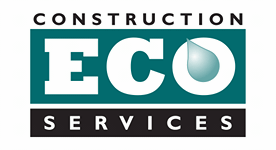Permeable Pavement: Always Care About Value – Not About Price
When it comes to the diversity of permeable pavement products on the market, it can be difficult to decide which one is best for your project. The client usually wants the cheapest option, leaving the designer in situation where performance and cost conflicts. In Texas and Louisiana the cheapest upfront option ends up being “plastic grid” permeable pavements. The concept behind this type of system is that the plastic grid provides structural support, while the voids are filled with angular chip rock. The grid structure filled with the stone provides the structural support for the traffic, while allowing stormwater to infiltrate the voids into a stone subbase. More often than not, there is an underdrain that conveys the water to the storm sewer system. The end result looks very similar to a gravel parking lot.
There are a few reasons this type of permeable pavement system is the cheapest on the market. The first one is that the performance (infiltration rate) will decrease within a short period of time. Usually within 6 months to a year. A common type of aggregate used in these systems is chip rock, usually #8 or #9 stone or a combination of both. Tire traffic can rip out these tiny stones, especially tires with aggressive knobs that can dig into the stone.
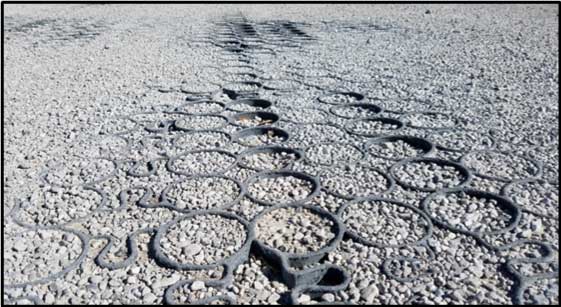
If the stone doesn’t get slung out, it will compact and break into smaller pieces. As the owner fills in the compacted stone with more aggregate, the stone ends up becoming so dense that water can no longer infiltrate. In the picture below, the top layer of aggregate was swept away to reveal all of the individual cells were filled with compacted aggregate.
How can water infiltrate pass this layer? A quick infiltration test (ASTC C1701) will demonstrate this permeable pavement is about as permeable as concrete. If the void space of the stone subbase is used for detention, there is absolutely no way for the water to reach it. Rather than being detained, it either ponds or sheet flows into the nearest catch basin. In the Gulf Coast, it’s extremely important for the detention volume to be available and reliable. Civil Engineers need to consider the performance of the permeable pavement if they are going to rely on it to decrease peak flow and increase time of concentration.
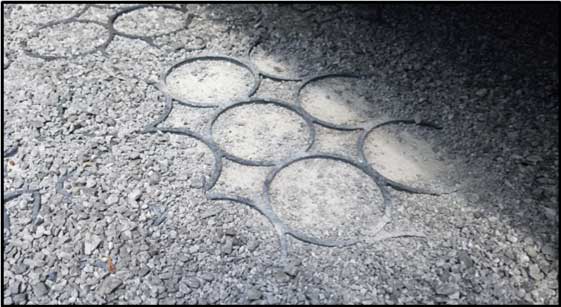 Another obvious reason for the lower upfront cost is that it’s impossible to maintain. The specifications for maintenance are slim to none and usually contain the statement, “require little or no maintenance”. One thing that is common among all stormwater Best Management Practices, they all require maintenance. Even if the product manufacturer provides a maintenance specification, the extent of it is filling in holes with more gravel as it becomes compacted. The majority of these specifications don’t discuss how to remove the sediment that is trapped in the voids of the stone, which is one of the functions of permeable pavement. As discussed in the first section, the compacted stone becomes so dense there is no way to remove the clogged aggregate. The entire grid system would need to be removed to restore the infiltration rate.
Another obvious reason for the lower upfront cost is that it’s impossible to maintain. The specifications for maintenance are slim to none and usually contain the statement, “require little or no maintenance”. One thing that is common among all stormwater Best Management Practices, they all require maintenance. Even if the product manufacturer provides a maintenance specification, the extent of it is filling in holes with more gravel as it becomes compacted. The majority of these specifications don’t discuss how to remove the sediment that is trapped in the voids of the stone, which is one of the functions of permeable pavement. As discussed in the first section, the compacted stone becomes so dense there is no way to remove the clogged aggregate. The entire grid system would need to be removed to restore the infiltration rate.
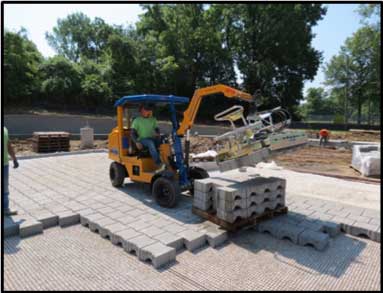 Even though plastic grid permeable pavements aren’t suitable for commercial projects, they are applications where they are successful. Residential homeowners can install this type of permeable pavement without the help of a contractor, making it an attractive option. In areas like New Orleans, residents that live in neighborhoods that are prone to flooding can benefit the most. The Urban Conservancy has been successful with getting homeowners using permeable pavements and bioretention to mitigate flooding issues. The Front Yard Initiative provides homeowners resources to solve the issue of excessive yard paving, while working to improve New Orleans’ safety, stormwater management, and beauty.
Even though plastic grid permeable pavements aren’t suitable for commercial projects, they are applications where they are successful. Residential homeowners can install this type of permeable pavement without the help of a contractor, making it an attractive option. In areas like New Orleans, residents that live in neighborhoods that are prone to flooding can benefit the most. The Urban Conservancy has been successful with getting homeowners using permeable pavements and bioretention to mitigate flooding issues. The Front Yard Initiative provides homeowners resources to solve the issue of excessive yard paving, while working to improve New Orleans’ safety, stormwater management, and beauty.
How can a Civil Engineer or Landscape Architect deliver a cost-effective solution to their client, but not sacrifice performance or maintenance? One solution that is currently being applied in the Gulf Coast is Permeable Articulating Concrete Blocks. The infiltration rate exceeds 2,000 in/hr and the robust maintenance specification ensures the system can be relied upon in all types of applications. What makes this type of system more cost-effective is the high drainage area ratio (up to 15:1). That means that for every 1,000 SF, it can drain up to 15,000 SF of impervious runoff. Rather than specify the entire parking surface as permeable pavement, the designer can use a fraction of the area with permeable articulating concrete blocks. One unique solution is to use the blocks along the gutter or curb, making it function like a trench drain. The stone depth can vary from 6” to deeper and be used for detention volume.
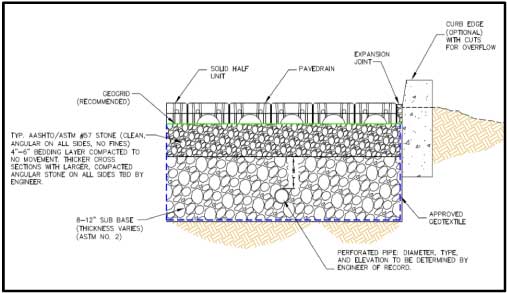 The best value for the designer and end user are the performance based specifications. The installer is responsible for performing infiltration tests post-construction to verify that the system wasn’t clogged with sediment. It also requires the installer to provide a minimum 36 month maintenance program; including a visual inspection report with photos and a recommended cleaning schedule with a Vacuum truck such as the Elgin® Whirlwind® or Megawind® or with the PaveDrain® Vac Head and associated combination sanitation vac truck.
The best value for the designer and end user are the performance based specifications. The installer is responsible for performing infiltration tests post-construction to verify that the system wasn’t clogged with sediment. It also requires the installer to provide a minimum 36 month maintenance program; including a visual inspection report with photos and a recommended cleaning schedule with a Vacuum truck such as the Elgin® Whirlwind® or Megawind® or with the PaveDrain® Vac Head and associated combination sanitation vac truck.
Next time you have a project and are considering permeable pavement, contact Construction EcoServices and let us guide you to the right solution. Our company is dedicated to driving change and doing the right thing for you and your client.
